Single-walled carbon nanotubes (SWCNTs) have high potential for improving the mechanical properties of composite materials owing to their unique structure and remarkable mechanical properties. A critical challenge in nanocomposite fabrication is to realize effective transfer of the excellent mechanical properties of SWCNTs to the macroscale mechanical properties of the matrix by adding SWCNTs as reinforcement.
A remarkable strengthening effect has been observed in SWCNT/polymer composites. However, up until now it has been difficult to fabricate SWCNT/metal composites with effective load transfer capacity because of the agglomeration of the SWCNTs in the matrix and the poor interfacial bonding between SWCNT and the metal matrix in the traditional powder-metallurgy processes.
This situation has now been changed by work from a team led by Sishen Xie and Weiya Zhou at the Institute of Physics, Chinese Academy of Sciences. They report a simple, easy and effective method to fabricate Cu/SWCNT/Cu sandwich-type laminated nanocomposites by means of electrodeposition using a freestanding SWCNT film with continuous reticulate structure as template. In the Cu/SWCNT/Cu laminated nanocomposites, not only can the SWCNT film keep continuous reticulate structure, but the orientation of SWCNTs can also be controlled. The continuous reticulate architecture of the SWCNT film and the strong interfacial strength between the SWCNT and Cu matrix result in an effective load-transfer capacity of the SWCNT bundles in the laminated nanocomposites. The estimated Young’s modulus of the SWCNT bundles in the composite are in a range of 860-960 GPa. Such high load-transfer efficiency leads to the extremely high mechanical strength of the laminated composites.
The mechanical performance of SWCNT-reinforced metal matrix composites essentially relies on the loading status of the SWCNTs in the composite. Therefore, it is crucial to understand the loading status of the SWCNTs in the composite during strain. Though Raman spectroscopy has been successfully applied to characterize the local strain of CNTs in the polymer matrix by the shift of Raman peaks, low content of CNTs and existence of bulky item make a Raman characterization of the loading status of CNTs in the CNT-reinforced metal-matrix composites under strain difficult. The reported thin Cu/SWCNTs/Cu laminated nanocomposite film overcomes above problems. The loading status of the SWCNTs in metal-matrix composite during strain was successfully characterized by Raman spectroscopy, which provides a route to investigate the load transfer of SWCNTs in the metal matrix composite.



















